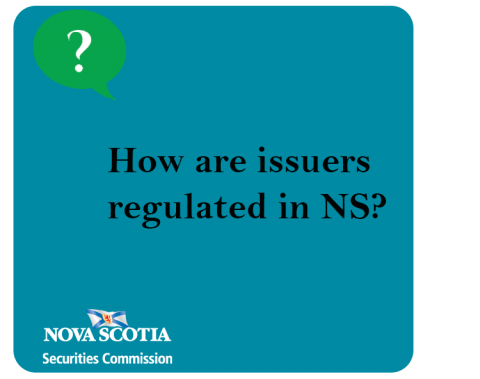Submitted by nsscadmin on

Once a company in Nova Scotia becomes a reporting issuer and sells shares to the public, it must comply with a number of regulations under the Nova Scotia Securities Act.
Before any securities can be issued or sold a company must first file a prospectus with the Nova Scotia Securities Commission. We’ll go into more detail as to what is found in a prospectus in a future post, but essentially a prospectus must include “specific, detailed disclosure about a company, its business and the securities being offered. It must provide full, true and plain disclosure of all material facts relating to the securities issued or proposed to be distributed.”
Once the prospectus has been approved and a receipt has been issued by NSSC, a reporting issuer may begin selling shares. Once they have reached this point a number of other requirements must be followed known as “continuous disclosure”.
Providing ongoing disclosure of the financial status, how management is performing and any material events affecting a reporting issuer is a cornerstone of securities regulation. The requirements include the ongoing disclosure of….
Financial Statements
Management Discussion & Analysis
Annual Information Forms
Business Acquisition Reports
Material Change Reports
Proxy Solicitation and Information Circulars
Here’s a basic rundown of each disclosure and what it entails for the issuer:
Financial Statements
The financial statements provide investors with a snapshot of a company’s financial position at a point in time and how it performed over a set period of time (i.e., annually, semi-annually or quarterly). A reporting issuer must file annual and interim financial statements with NSSC. The financial statements must include a statement of financial position, a statement of comprehensive income, a statement of changes in equity and a statement of changes in cash flows and notes to the financial statements.
Management Discussion & Analysis
This is a narrative explanation made by a reporting issuer’s management. It outlines in writing how the company performed during the period covered by their financial statements. It fully outlines the company’s current financial situation and future prospects. These must be filed with a company’s financial statements.
Annual Information Forms
These forms must be filed within 90 days after a company’s most recent financial year. The form lists material information about the company and its business in context of both historical and possible future development. It also describes the company and its operations, prospects, risks and any other factors that may impact it business going forward.
Business Acquisition Reports
Whenever a company completes a significant acquisition it must file a Business Acquisition Report (BAR). The BAR outlines the significant business or businesses that have been acquired and the effect it has on the company. These reports must be filed within 75 days of an acquisition.
Material Change Reports
Reporting issuers must publicly disclose any material changes to their affairs. This could include any change in business operations, or capital of a company that would within reason be expected to have a significant effect of the market price or value of it securities. Or, a decision to implement such a change in the future made by the board of directors, senior management, or by other persons acting in a similar capacity.
When a material change occurs, reporting issuers must immediately issue a news release disclosing the change. A material change report must be filed as soon as possible, and within 10 days of the change occurring.
Proxy Solicitation and Information Circulars
A proxy allows a shareholder to appoint another person or company to act on his or her behalf at a shareholder meeting. When a company solicits a proxy, it may also prepare an information circular.
An information circular must include information on exercising the proxy and details of the matters to be voted on at the shareholder meeting.
